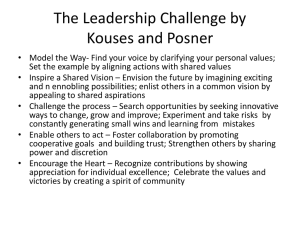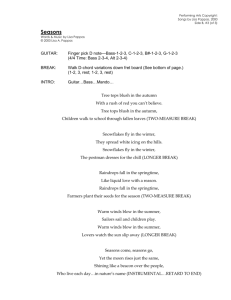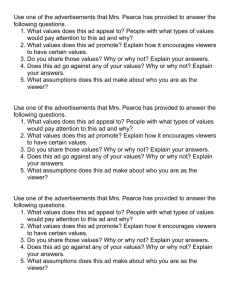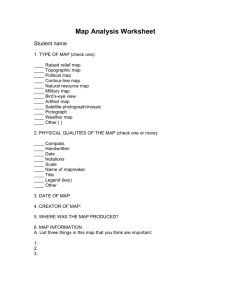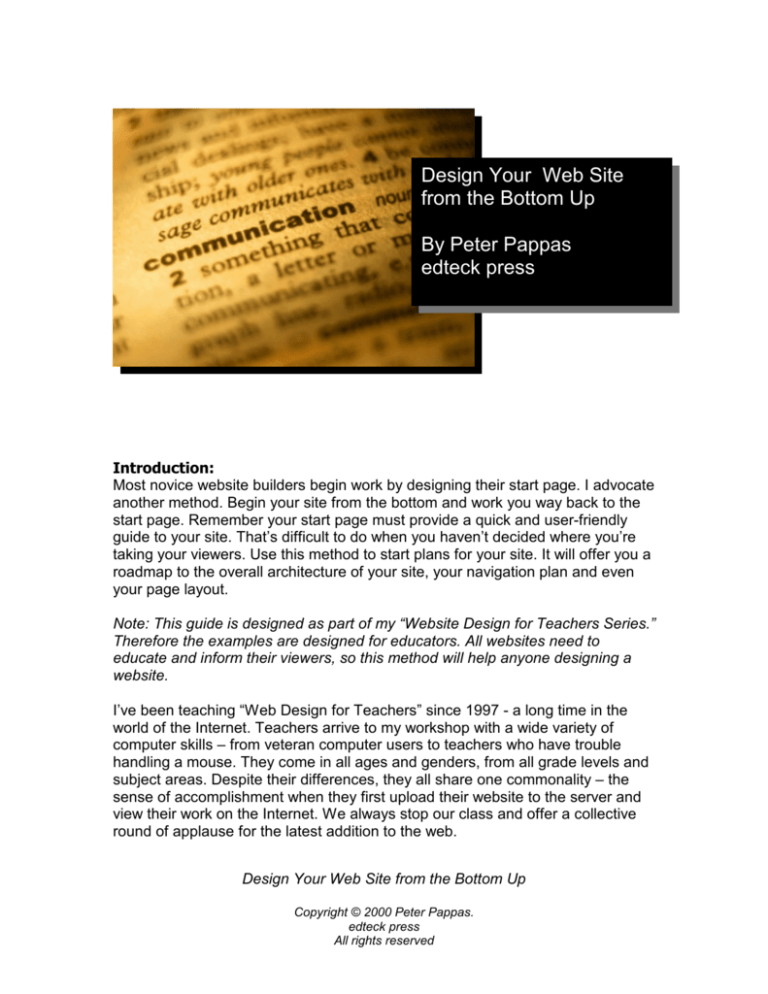
Design Your Web Site
from the Bottom Up
By Peter Pappas
edteck press
Introduction:
Most novice website builders begin work by designing their start page. I advocate
another method. Begin your site from the bottom and work you way back to the
start page. Remember your start page must provide a quick and user-friendly
guide to your site. That’s difficult to do when you haven’t decided where you’re
taking your viewers. Use this method to start plans for your site. It will offer you a
roadmap to the overall architecture of your site, your navigation plan and even
your page layout.
Note: This guide is designed as part of my “Website Design for Teachers Series.”
Therefore the examples are designed for educators. All websites need to
educate and inform their viewers, so this method will help anyone designing a
website.
I’ve been teaching “Web Design for Teachers” since 1997 - a long time in the
world of the Internet. Teachers arrive to my workshop with a wide variety of
computer skills – from veteran computer users to teachers who have trouble
handling a mouse. They come in all ages and genders, from all grade levels and
subject areas. Despite their differences, they all share one commonality – the
sense of accomplishment when they first upload their website to the server and
view their work on the Internet. We always stop our class and offer a collective
round of applause for the latest addition to the web.
Design Your Web Site from the Bottom Up
Copyright © 2000 Peter Pappas.
edteck press
All rights reserved
When I first stated teaching “Web Design for Teachers” my focus was on the
technical side of the process. Teachers spent hours learning how to set text and
images, layout pages and build hyperlinks. But I’ve learned that they can quickly
master the technical side of making a web page. After a quick overview of the
software, most teachers can begin building a website within a few hours. New
web authoring software like FrontPage makes web design about as easy as word
processing.
Most find that the real challenge is mastering the architecture and design of a
website. So let’s get started designing from the bottom up.
Table of Contents:
Step 1: Brainstorm
Step 2: Grouping the information
Step 3: Critique the categories
Step 4: Revise your categories
Step 5: Develop a flow chart
Step 6: Design a navigational plan
Step 7: Page layout
Step 8: Don’t forget to keep it simple
Step 9: Finally, you get to make your homepage
Step 10: Congratulate yourself and get ready to upload your
server
About the author: Over his 30-year career in education, Peter Pappas has
worked with school districts from across the nation as consultant for technology
integration, staff development, curriculum and assessment design. He has been
the recipient of state and national fellowships and has authored or contributed to
textbooks, teacher resource books, assessment packages, and professional
journals. Currently he’s exploring the ways that Internet can be better harnessed
to improve student performance and the quality of teaching and learning. His
homepage is found at: www.edteck.com
Design Your Web Site from the Bottom Up
Copyright © 2000 Peter Pappas.
edteck press
All rights reserved
Step 1: Brainstorm
Brainstorm a list of all the items you’d like to have in your
website. This list can include items that will you will produce
for your site and links from your site to other sites. As you
make this list think about your audience and the information
that they are looking for. Also consider the information that
you might already have available. Remember that any
documents or images that your already have in the
computer can be easily incorporated into the website.
Consider all the information that is already available on he Internet. You can host
all this information for your viewers. Frequently they have difficulty sorting
through all the stuff on line to find out what' really valuable.
Here are a few to help you get started (remember I’m using example for
educators, but the rest of you can come up with a your own list):
Homework
Cool links
Guide to writing
FYI
Puzzles
My email
Book list
Requirements
Activities
Newsletter
Student work
Syllabus
For parents
Calendar
Contact me
Assignments
Meeting dates
For students
Supply list
Test review
Start your list here:
Design Your Web Site from the Bottom Up
Copyright © 2000 Peter Pappas.
edteck press
All rights reserved
Textbook
Club outings
Unit objectives
What’s new?
Grades
Step 2: Grouping
Try to group all your items into 2 to 4 categories. See if
you can come up with a name for each category. It
should be short and descriptive. You might think about
dividing up your information according to the viewer. You
could make a category for students and another for
parents or you might group by students in different classes
or grades. You might try putting each item on a sticky note
or index card and rearranging them into categories.
News
Homework
Puzzles
Activities
Calendar
Test review
Student work
Class Info
Guide to writing
Syllabus
Unit objectives
Supply list
Book list
Cool links
Put your “Post-its” here:
Design Your Web Site from the Bottom Up
Copyright © 2000 Peter Pappas.
edteck press
All rights reserved
For parents
Contact me
Book list
Student work
Syllabus
Homework
Step 3: Critique
the categories
Now its time to look at your categories with a critical eye
answer these questions:
a. Who is my audience? What are they’re looking for?
Think of the web sites that you've been to that quickly directed you to
what you were looking for. Think of others that took you on endless
paths that eventually forced you to leave the site.
b. What’s most important to them? Will it be easy to find?
The most important information to your viewer should not be more than
a couple of clicks down into your site. Students want to quickly find
their homework assignment and parents might want quick access to
your telephone number or email address.
c. Will they have to jump between categories to find what they need?
Ever remodel a kitchen? You probably know that the stove, refrigerator
and sink need to be in close proximity. The same holds true for a
website. If you intend to post an assignment on line then the resources
or reading that go along with it should be closely linked, not three clicks
away. Remember if you want your students to be successive, you
need to include explicit instruction and guidelines that clearly spell out
your expectations. That's even more important when designing a
website. If you want them to use a specific format for an assignment
then put a prominent link to the format guide right on the assignment
page.
d. Should some items be in more than one category?
Both parent and students may want to access the homework
assignments. If you choose to have homework appear in both
categories remember you can build hyperlinks to the same homework
page from more than one category in your website.
Design Your Web Site from the Bottom Up
Copyright © 2000 Peter Pappas.
edteck press
All rights reserved
e. What items will stay the same, or will they need frequent updating?
This is important since your website should make your life easier, not
become a project that demands constant attention. You might consider
designing one section of your site that won't need much updating, and
another that will be updated on a regular basis. This will help you to
stay focused on the sections of the site that will need revisions. Do
yourself a favor and don't set overly ambitions goals for yourself. The
"Quote of the Day" may sound like a good idea when you get started,
but be sure you intend to keep it up. A weekly "review guide" may be a
more manageable task.
f. Do the categories make sense? Do they describe what’s in them?
You won't be around to guide your audience through your website. You
might think that an image of an owl makes a good link to your resource
list, but will the viewer know that? It's great to use some artistic
creativity, but your site needs to be clear in its organization and
navigation. Also remember that you may be reaching a diverse
audience with special needs that can be addressed in the design of
your site.
Step 4: Revise
your categories
Revise the categories and items as needed. Stay focused on what it will be like
for your audience to find the information they want. Remember that when
confronted with new information people make their own assumptions about what
information they’ll find and where the will go to get it.
Design Your Web Site from the Bottom Up
Copyright © 2000 Peter Pappas.
edteck press
All rights reserved
Step 5: Develop
a flow chart
Finalize the categories and items in them and make them into an organizational
flow chart. This chart will become your roadmap for site design. It will enable you
to design a clear navigational structure, plus help you to keep track of you pages.
Below you see a portion of the flow chart for this sample site. It consists of three
levels:
Level 1
Level 2
Level 3
Start page
Course Info
News
Homework
Calendar
Syllabus
Supply list
For parents
Booklist
Contact me
Start page
News
For parents
Course info
Homework
Book list
Syllabus
Calendar
Supply list
Design Your Web Site from the Bottom Up
Copyright © 2000 Peter Pappas.
edteck press
All rights reserved
Contact me
As you layout your flow chart you need to balance the breadth and depth of the
design. For example, if you had 12 second level pages and no third level you
would have a very broad and shallow site that would force the viewer to sort
through a long laundry list of second level page choices. In contrast a site with
only 3 second level pages and a depth down to 5 levels might force the viewer to
click down through too many levels to reach the information they were looking
for. As with most things in life, look for a balance.
Step 6: Design a
navigational plan
Now you need to think about he navigational path that viewers will use to move
around your site. Most likely they will begin on the start page and click to a
second level page and perhaps down to a third level page. Many will simple use
the back button on the browser to return to the start.
But you also need to develop a navigational system to give them short cuts from
one portion of the site to another without have to use the back button. Once
again balance is the key. You need to offer them enough short cut links to other
areas of your site, but not so many to confuse them or clutter the page. It is
impractical to provide links directly connecting every page in your site.
I find that the best approach is to put a navigation bar on every page that links to
the start page and each of the second level pages. This simplified navigational
structure gives the viewer a limited number of direct links to recognizable
reference point in the site. In the current example I would use:
start | news | info | parents
Each of your pages in the site can begin with this navigation bar. It’s a clear
guide the viewer to the start page or any of the second level pages in the site.
Notice that each of the links is a short word. Remember that space is at a
premium on each page. You may have to use some creativity to develop short
words for a navigation bar.
Design Your Web Site from the Bottom Up
Copyright © 2000 Peter Pappas.
edteck press
All rights reserved
Once you make your hyperlinks, it's easy to copy and paste them into the top of
every page in your site. This navigational system doesn’t allow the viewer to go
directly from one third level page to another third level page, but most people will
quickly learn how to get around your site.
Many web designers use frames to create navigational structure, but they create
problems that can outweigh their functionality. Many people rely on the “Back
button” of their browser to get around. Frames can confuse that technique.
Frames also make it difficult for people to bookmark or print out specific pages in
the site. The frames also use up valuable screen space when they run
continuously down the margin of a page.
I strongly recommend putting your navigation bar at the top and bottom of very
page. If you choose to use a navigational bar on the side of the page, you'll be
using up valuable screen space. The top / bottom navigation maximizes your
usable screen space plus its easier to build into each page as a header and
footer. Viewers will want to navigate from both the top and bottom of your page
so they don’t have to scroll up or down to move to another page in your site.
You should include some information that identifies your site and the designer at
the bottom of very page. Sometime search engines will pick up a direct link to a
lower level of your site. For example a search engine might take viewers directly
to one of your third level. They need to quickly know where they have arrived and
be provided with information about the site and a chance to get back to your start
page. You need to brand the page and provide navigation back to your home
page or you might find a new viewer at your site stranded on an “orphan page.”
Then they have only one place to go – they’ll use the browser back button and
return to the search engine. You just lost a viewer.
If you use images as part of your navigational structure, remember to put a
second text only navigation bar somewhere else on the page. Some people
browse the web with the images "turned off." Others may be visually impaired
and rely on software to read the web to them. In both cases they will need to
have a text alternative to an image-only navigation bar.
Design Your Web Site from the Bottom Up
Copyright © 2000 Peter Pappas.
edteck press
All rights reserved
Step 7: Page
layout
Follow the guide above and include the following on each page:
Navigation links at the top and bottom of very page
Identifying information on site name and organization
Page Content
Also remember to clearly identify the title of the current page. Viewers need to
know where they are in your site. A bold graphic always helps. Remember that
the browser window only displays a limited portion of each page starting the top.
Be sure to include all the important information “above the fold” at trick
newspaper editors learned years ago. If you have a graphic that will take some
time to load, be sure to give the viewer some text at the top of the page so they
don’t get impatient and leave before the graphic come up.
Remember that each page can be as “long” as you like, but the most important
information should be at the top of each page. While viewers are used to
scrolling down the page, you don’t want to over do it. Remember you can always
build a link to another page if it’s getting too crowded. Most importantly do not
build a page that is too wide (over 600 pixels). No one likes to scroll form side to
side.
start | news | info | parents
Supply List
Content
Content
Ms. Teacher’s Geometry Class
City High School
start | news | info | parents
Design Your Web Site from the Bottom Up
Copyright © 2000 Peter Pappas.
edteck press
All rights reserved
Step 8: Don’t forget
to keep it simple
Most viewers want to quickly find the information that they’re looking for. Don’t
clutter up the page with scrolling banners and animations that distract from the
message of the site. And who wants to wait while your sound file of the “National
Anthem” loads?
Every graphic you add to the page will increase the download time. Most viewers
quickly lose interest in waiting for your page to appears. Load time is especially
important at the top end of your site. Be sure that your start page and second
level pages load very quickly. If you must include some graphic intensive pages,
do it lower in your site. This way if the viewer gets impatient and hits the back
button, they will still be in your site.
Design Your Web Site from the Bottom Up
Copyright © 2000 Peter Pappas.
edteck press
All rights reserved
Step 9: Finally, you get
to make your homepage
Ms. Teacher’s
Geometry Class
What’s new?
Course info
For parents
City High School
Email: msteacher@school
Last update May 2000
Step 10: Congratulate
yourself and get ready
to upload to your server.
But don’t get smug, remember that building and updating a web site is an on
going project. And please don’t add any cute “under construction” clip art to your
site. They’re always under construction.
Design Your Web Site from the Bottom Up
Copyright © 2000 Peter Pappas.
edteck press
All rights reserved

